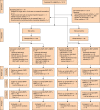Neuromuscular Electrical Stimulation for Intermittent Claudication (NESIC): multicentre, randomized controlled trial
- PMID: 37748866
- PMCID: PMC10638544
- DOI: 10.1093/bjs/znad299
Neuromuscular Electrical Stimulation for Intermittent Claudication (NESIC): multicentre, randomized controlled trial
Abstract
Methods: This was an open, multicentre, randomized controlled trial. Patients with intermittent claudication attending vascular surgery outpatient clinics were randomized (1:1) to receive either neuromuscular electrical stimulation (NMES) or not in addition to local standard care available at study centres (best medical therapy alone or plus supervised exercise therapy (SET)). The objective of this trial was to investigate the clinical efficacy of an NMES device in addition to local standard care in improving walking distances in patients with claudication. The primary outcome was change in absolute walking distance, measured by a standardized treadmill test at 3 months. Secondary outcomes included intermittent claudication (IC) distance, adherence, quality of life, and haemodynamic changes.
Results: Of 200 participants randomized, 160 were included in the primary analysis (intention to treat, Tobit regression model). The square root of absolute walking distance was analysed (due to a right-skewed distribution) and, although adjunctive NMES improved it at 3 months, no statistically significant effect was observed. SET as local standard care seemed to improve distance compared to best medical therapy at 3 months (3.29 units; 95 per cent c.i., 1.77 to 4.82; P < 0.001). Adjunctive NMES improved distance in mild claudication (2.88 units; 95 per cent c.i., 0.51 to 5.25; P = 0.02) compared to local standard care at 3 months. No serious adverse events relating to the device were reported.
Conclusion: Supervised exercise therapy is effective and NMES may provide further benefit in mild IC.This trial was supported by a grant from the Efficacy and Mechanism Evaluation Program, a Medical Research Council and National Institute for Health and Care Research partnership. Trial registration: ISRCTN18242823.
Plain language summary
Patients with intermittent claudication experience pain in their legs during walking or exercise which ends with rest. This severely impairs physical activity and quality of life. Treatment for such patients typically involves best medical therapy, which includes exercise advice. This study aimed to determine whether a neuromuscular electrical stimulation device improved the walking distance of patients with intermittent claudication compared to local standard care available (which may include supervised exercise therapy) in a trial. Supervised exercise improved walking distances but there was no difference in those that received a device in this patient group.
© The Author(s) 2023. Published by Oxford University Press on behalf of BJS Society Ltd.
Figures

References
-
- Morley RL, Sharma A, Horsch AD, Hinchliffe RJ. Peripheral artery disease. BMJ 2018;360:j5842. - PubMed
-
- National Health Service (NHS) . Diagnosis. Peripheral arterial disease (PAD).https://www.nhs.uk/conditions/peripheral-arterial-disease-pad/diagnosis/
-
- Fowkes FG, Housley E, Cawood EH, Macintyre CC, Ruckley CV, Prescott RJ. Edinburgh Artery study: prevalence of asymptomatic and symptomatic peripheral arterial disease in the general population. Int J Epidemiol 1991;20:384–392 - PubMed

